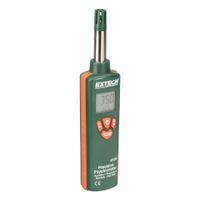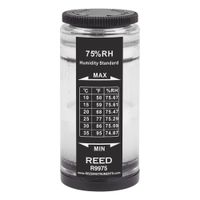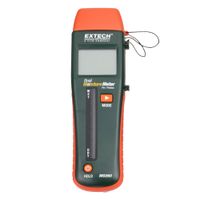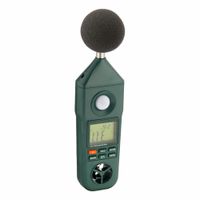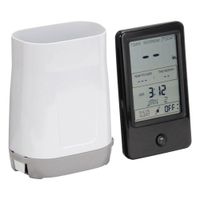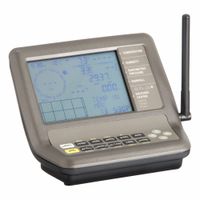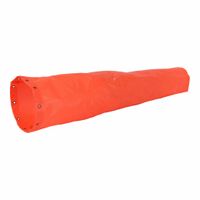Call +(254) 703 030 000 / 751 483 999 / 721 704 777
- Home
- Test Instruments
- Temperature And Environmental Measurement
- Environmental Measurement
.....Read More
Frequently Asked Questions
What are the best environmental measurement products for home use?
The best environmental measurement products for home use include:
1. **Air Quality Monitors**: Devices like the Awair Element or IQAir AirVisual Pro measure pollutants such as PM2.5, CO2, VOCs, and humidity, providing real-time data to help improve indoor air quality.
2. **Smart Thermostats**: Products like the Nest Learning Thermostat or Ecobee SmartThermostat optimize heating and cooling, reducing energy consumption and maintaining comfortable indoor temperatures.
3. **Humidity Sensors**: Devices such as the Govee Hygrometer Thermometer monitor indoor humidity levels, crucial for preventing mold growth and maintaining comfort.
4. **Water Quality Test Kits**: Kits like the Watersafe Drinking Water Test Kit allow homeowners to test for contaminants such as lead, bacteria, and pesticides, ensuring safe drinking water.
5. **Radon Detectors**: Products like the Airthings Wave Plus provide continuous radon monitoring, essential for detecting this odorless gas that can pose serious health risks.
6. **Smart Plugs and Energy Monitors**: Devices like the TP-Link Kasa Smart Plug or Sense Energy Monitor track energy usage, helping to identify high-consumption appliances and reduce electricity bills.
7. **Noise Level Meters**: Tools like the BAFX Products Decibel Meter measure sound levels, useful for maintaining a peaceful home environment and ensuring compliance with local noise regulations.
8. **Soil Moisture Sensors**: Products like the Xiaomi MiFlora monitor soil moisture, light, and temperature, aiding in efficient garden and plant care.
9. **Carbon Monoxide Detectors**: Devices such as the Kidde Carbon Monoxide Alarm provide alerts for dangerous CO levels, crucial for preventing poisoning.
10. **Weather Stations**: Systems like the Netatmo Weather Station offer comprehensive data on temperature, humidity, air pressure, and more, helping homeowners plan activities and manage energy use efficiently.
How do digital temperature and humidity meters work?
Digital temperature and humidity meters, also known as hygrometers, work by using sensors to measure environmental conditions and then displaying the data on a digital screen.
For temperature measurement, these devices typically use a thermistor or a thermocouple. A thermistor is a type of resistor whose resistance changes with temperature. The device measures the resistance and converts it into a temperature reading using a pre-calibrated scale. A thermocouple, on the other hand, consists of two different metals joined at one end. It generates a voltage that is temperature-dependent, which is then converted into a temperature reading.
For humidity measurement, digital meters often use capacitive or resistive sensors. Capacitive sensors consist of a hygroscopic dielectric material placed between two electrodes. As humidity changes, the dielectric constant of the material changes, altering the capacitance. This change is measured and converted into a humidity reading. Resistive sensors use a hygroscopic salt or polymer that changes resistance with humidity. The device measures this resistance change and converts it into a humidity percentage.
The digital meter's microcontroller processes the signals from these sensors, applies necessary calibrations, and displays the results on an LCD or LED screen. Some advanced models may also include features like data logging, alarms, or connectivity options for remote monitoring.
Overall, digital temperature and humidity meters provide accurate, real-time environmental data, making them essential tools in various applications, from weather monitoring to industrial processes and home climate control.
What factors should I consider when choosing a moisture meter?
When choosing a moisture meter, consider the following factors:
1. **Type of Material**: Determine the material you will be measuring (wood, concrete, soil, etc.) as different meters are designed for specific materials.
2. **Pin vs. Pinless**: Pin meters use probes to penetrate the material, providing accurate readings but potentially damaging the surface. Pinless meters use sensors to scan the surface, offering non-destructive testing.
3. **Measurement Range**: Ensure the meter covers the moisture range relevant to your needs. Different applications require different ranges.
4. **Accuracy and Resolution**: Look for meters with high accuracy and resolution to ensure precise measurements, especially for professional use.
5. **Calibration**: Check if the meter requires regular calibration and if it offers easy calibration options to maintain accuracy over time.
6. **Display and Readability**: Choose a meter with a clear, easy-to-read display, especially if you’ll be using it in low-light conditions.
7. **Durability and Build Quality**: Consider the build quality, especially if you’ll be using the meter in harsh environments. Look for water-resistant or rugged designs if necessary.
8. **Size and Portability**: Consider the size and weight of the meter for ease of use and portability, especially if you need to carry it around frequently.
9. **Battery Life**: Check the battery life and whether it uses replaceable or rechargeable batteries for convenience.
10. **Additional Features**: Look for additional features like data storage, Bluetooth connectivity, or temperature compensation, which can enhance functionality.
11. **Brand and Reviews**: Consider reputable brands and read user reviews to gauge reliability and performance.
12. **Price and Warranty**: Balance your budget with the features you need and check for a warranty to protect your investment.
How accurate are heat stress monitors in predicting dangerous conditions?
Heat stress monitors are generally accurate tools for assessing environmental conditions that could lead to heat-related illnesses. These devices measure various parameters such as temperature, humidity, wind speed, and solar radiation to calculate indices like the Wet Bulb Globe Temperature (WBGT), which is widely used to evaluate heat stress risk.
The accuracy of these monitors depends on several factors:
1. **Sensor Quality**: High-quality sensors provide more precise readings. Calibration and maintenance are crucial to ensure ongoing accuracy.
2. **Environmental Factors**: Rapid changes in weather conditions can affect readings. Monitors may not instantly reflect these changes, potentially leading to delayed warnings.
3. **Placement and Exposure**: Proper placement is essential. Monitors should be positioned in representative locations, avoiding direct sunlight or obstructions that could skew data.
4. **Human Factors**: Individual susceptibility to heat stress varies based on factors like acclimatization, hydration, clothing, and physical condition. Monitors provide environmental data but cannot account for these personal variables.
5. **Data Interpretation**: The effectiveness of heat stress monitors also relies on correct data interpretation and timely decision-making by users. Training and experience are vital for accurate risk assessment.
While heat stress monitors are valuable for predicting dangerous conditions, they are not infallible. They should be used as part of a comprehensive heat stress management plan, including regular monitoring, worker education, and emergency response strategies. Combining technological data with human judgment enhances the ability to prevent heat-related illnesses effectively.
What features should I look for in a multifunction environmental meter?
When selecting a multifunction environmental meter, consider the following features:
1. **Measurement Capabilities**: Ensure it can measure key environmental parameters such as temperature, humidity, air velocity, light, and sound levels. Some advanced models may also measure CO2 levels, barometric pressure, and dew point.
2. **Accuracy and Range**: Check the accuracy specifications and measurement range for each parameter to ensure they meet your requirements.
3. **Display**: Look for a clear, backlit LCD display that can show multiple parameters simultaneously. A graphical display can be beneficial for trend analysis.
4. **Data Logging and Storage**: Opt for a meter with data logging capabilities, allowing you to store and review data over time. Check the storage capacity and whether it supports external memory cards.
5. **Connectivity**: Consider models with Bluetooth or USB connectivity for easy data transfer to computers or mobile devices. Some may offer app integration for real-time monitoring.
6. **Calibration**: Ensure the meter can be easily calibrated, either manually or automatically, to maintain accuracy over time.
7. **Durability and Build Quality**: Choose a robust, weather-resistant design suitable for the environments you will be measuring in. Look for IP ratings for dust and water resistance.
8. **Portability**: A compact, lightweight design with a carrying case can be beneficial for fieldwork.
9. **Power Source**: Check battery life and whether it uses replaceable or rechargeable batteries. Some models may offer solar charging.
10. **User Interface**: A user-friendly interface with intuitive controls and menu navigation is essential for efficient operation.
11. **Accessories**: Consider included accessories like tripods, probes, or protective covers that enhance functionality.
12. **Brand Reputation and Support**: Choose a reputable brand known for quality and customer support, including warranty and service options.
How do I calibrate my weather station for accurate readings?
1. **Placement**: Ensure your weather station is placed in an open area, away from obstructions like buildings or trees that can affect readings.
2. **Temperature Calibration**: Compare your station's temperature readings with a reliable thermometer. Adjust the settings on your station if there's a consistent discrepancy.
3. **Humidity Calibration**: Use a hygrometer to check humidity levels. If your station's readings differ, adjust the humidity settings according to the manufacturer's instructions.
4. **Barometric Pressure Calibration**: Obtain the current barometric pressure from a nearby reliable source, such as a local airport. Adjust your station's pressure settings to match this reference.
5. **Wind Speed and Direction Calibration**: Ensure the anemometer is mounted at the recommended height (usually 10 meters above ground). Compare wind readings with a nearby official weather station and adjust if necessary.
6. **Rain Gauge Calibration**: Check the rain gauge for debris and ensure it's level. Pour a known amount of water into the gauge and compare the reading to the actual amount. Adjust the calibration settings if there's a discrepancy.
7. **Regular Maintenance**: Clean sensors regularly and check for any physical damage. Replace batteries and update firmware as needed.
8. **Consult the Manual**: Refer to the user manual for specific calibration instructions and troubleshooting tips for your model.
9. **Professional Calibration**: If you're unable to achieve accurate readings, consider professional calibration services.
10. **Data Logging and Comparison**: Regularly log data and compare it with nearby official weather stations to ensure ongoing accuracy.
What is the difference between wired and wireless sensors in environmental measurement devices?
Wired sensors in environmental measurement devices are connected to a central system via physical cables. These sensors are typically more reliable in terms of data transmission, as they are less susceptible to interference from external sources. They offer consistent power supply through the cables, which can be advantageous for continuous monitoring. However, wired sensors can be limited by the need for extensive cabling, which can be costly and cumbersome to install, especially in remote or difficult-to-access locations. Maintenance can also be challenging, as physical connections may degrade over time.
Wireless sensors, on the other hand, communicate data through radio waves, Wi-Fi, Bluetooth, or other wireless protocols. They offer greater flexibility in terms of placement, as they are not constrained by cables. This makes them ideal for remote or hard-to-reach areas. Wireless sensors are generally easier and quicker to install and can be part of a scalable network. However, they may face issues with signal interference, limited range, and battery life, which can affect data reliability and require regular maintenance. Security can also be a concern, as wireless transmissions can be more vulnerable to unauthorized access.
In summary, the choice between wired and wireless sensors depends on factors such as the environment, required data reliability, installation complexity, and maintenance capabilities.


